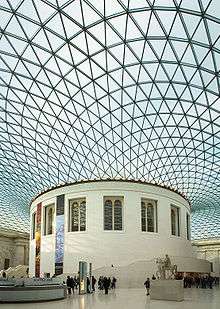Lion of Knidos
|
Lion of Knidos | |
| Material | Marble |
|---|---|
| Size | 2.89 m long by 1.82 m high |
| Created | c. 350-200 BC |
| Present location | British Museum, London |
| Registration | 1859,1226.24 |
The Lion of Knidos is the name for a colossal ancient Greek statue that was discovered in 1858 near the ancient port of Knidos, south-west Asia Minor (now near Datça in Turkey). Soon after its discovery, the statue was shipped to London where it became part of the British Museum's collection. Although there is some debate about the age of the sculpture, in general, scholarly opinion dates it to the 2nd century BC. Since 2000, it has been prominently displayed on a plinth under the roof of the Queen Elizabeth II Great Court.[1]
Description
This sculpture of a recumbent lion was quarried from Mount Pentelikon near Athens, the same marble used to build the Parthenon. The lion is substantially complete; only the lower jaw and front legs are missing; its eyes were probably once inlaid with glass. The statue is greater than life-size; it weighs six tonnes and measures 2.89 metres long and 1.82 metres high.[1] In designing the body to be hollowed out from below, the weight of the statue was reduced.[2]
The statue stood on top of a funerary monument that is of a style fashionable in 350 BC in Halikarnassos, a centre that was only a day away by boat. The monument is square with a stepped pyramidal top. It was hollow on a circular plan.[3] This similarity has led to some experts dating the statue to 350 BC, but others think that the statue was above a cenotaph made to commemorate the nearby naval Battle of Cnidus of 394 BC, in which the Athenian general, Conon, commanding a joint Athenian and Persian fleet, was victorious over a Spartan fleet led by Peisander.[4]
A third opinion is that the architecture of the monument is not typical of 250 BC, but is Doric and dates from 175 BC. This variation is summarised in the British Museum's estimate of 200-250 BC as its age.[3] The rest of the monument is still in Turkey[4] where it has been excavated by the British Museum.[5] It was originally 12 metres square. Excavations at the site, and similar monuments nearby, have failed to find an artefact or inscription that would more definitely date the statue.[6]
Discovery
The Lion of Knidos was found in 1858 by the British archaeologist Richard Popplewell Pullan as he walked the cliffs near what is now the Turkish town of Datça. Three miles away Pullan was helping Charles Thomas Newton excavate the ancient Greek city of Knidos.[1] The statue had crowned an 18-metre high funerary monument, which had commanding views over the sea and may have once acted as a navigation aid for passing sailors. The monument may have been destroyed in an earthquake, as the statue was found lying some distance from the tomb. The Knidos Lion was transported with some difficulty further down the coast, where it was loaded onto the naval ship HMS Supply by Robert Murdoch Smith and shipped to London.[1]
Smith's role was significant, as he was presented with a large statue that had fallen onto its front face. The limestone core of the monument was still there but the marble facing had either been stolen or lay around where it had fallen. Smith was able to replace and move each of the remaining stones which allowed Pullen, who was a trained architect, to sketch what is thought to be a good reproduction of what the whole structure would have looked like.[2]
In 2008 the Turkish town of Datça petitioned the British Ministry of Culture and Tourism for the return of the two statues known as the Lion of Knidos and the Demeter of Knidos.[7]
References
- 1 2 3 4 British Museum Collection The Lion of Knidos, British Museum, retrieved 30 November 2013
- 1 2 Jenkins, Ian (2006). Greek architecture and its sculpture. New York: Harvard University Press. ISBN 0674023889.
- 1 2 Colossal marble lion from a tomb monument, British Museum Highlights, retrieved 1 December 2013
- 1 2 Knidos, Planetware.com, retrieved 2 December 2013
- ↑ Jenkins, Ian (2006). "Return to Cnidus". Anatolian Archaeology. 12: 26–28.
- ↑ Winter, Frederick E. (2006). Studies in Hellenistic architecture. Toronto [u.a.]: Univ. of Toronto Press. p. 81. ISBN 0802039146.
- ↑ Turkey wants Knidos Lion to be returned, Elginism.com, retrieved 30 November 2013
Further reading
| Wikimedia Commons has media related to Lion of Knidos. |
- Ian Jenkins, The Lion of Knidos, British Museum, 2008
- C. Bruns-Ozgan, Knidos: A Guide to the Ancient Site, Konya 2004
- G.Bean, Cnidus, Turkey beyond the Maeander, London 1980, chapter 12, pp 111–127

